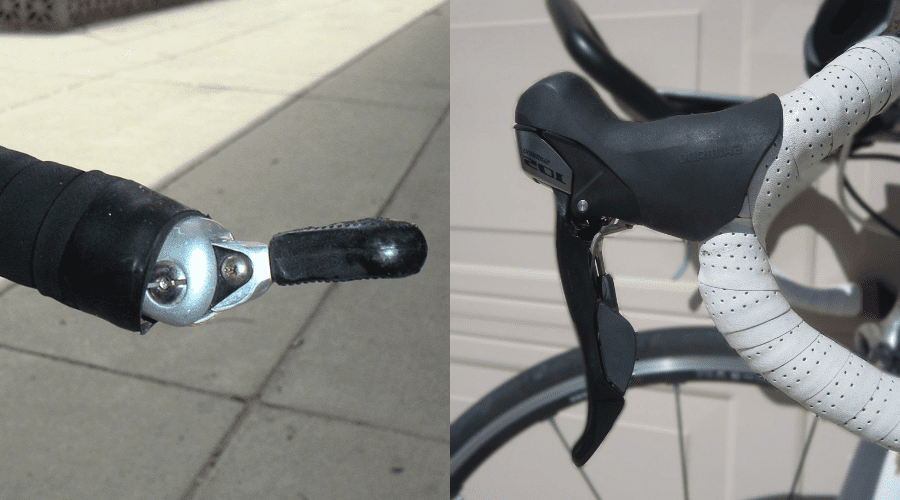Bar end shifters are an older and simpler technology than brifters, though both have advantages. Modern, high-tech integrated shifters do the job of precise index shifting and braking in one convenient location where you don’t move your hands.
Bar end shifters offer index and friction shifting separate from the brakes, but you have to change hand position to stop. Which type of shifter is better?
In the battle of bar end shifters versus brifters, there are a lot of differences, but bar end shifters are better. Although an integrated system is alright, changing your hand position to stop isn’t enough incentive to upgrade. Brifters are a more complex and breakable mechanism that is less versatile, harder to fix, and tends to cause chain rubbing.
Recommended Gear
To see all of my up-to-date recommendations for bikes and cycling gear, check out this resource that I made for you!
Table of Contents
Which Is Better Bar End Shifters or Brifters
In my opinion, bar end shifters are better than brifters. Upgrading doesn’t always guarantee that you are getting a better product, just one that is different and usually more complex.
Brifters and bar end shifters are a perfect example of this concept.
Your classic bar end shifter is inexpensive, ultra-reliable, easy to repair, and it doesn’t break easily.
Meanwhile, the brifter is nice because you don’t move your hands to shift, and it’s faster. Pu you can brake using the same device.
Ultimately that’s about all it brings to the table. An integrated, more specialized, less reliable, harder to repair system that is typically more costly is not the sort of ‘upgrade’ I prefer.
What Are Bar End Shifters
Bar end shifters go on the endcaps of your handlebars. They are a switch that rotates on a drum.
There is a cable coming off of them that controls chain movement via derailleur so you can swap up and down through larger and smaller sprockets to shift gears.
The derailleur pushes the chain into a new position (only while pedaling) based on how you move the switch.
These versatile shifters are compatible with almost any bike model and can attach to nearly any cassette regardless of how many speeds it has.
With fewer parts, these end-of-handlebar shifters still offer two types of shifting, and they rarely break.
If you’re looking for a bike shifter that has stood the test of time and remains relevant while also looking like the classic it is, then bar end shifters are right for you.
Pros And Cons Of Bar End Shifters
Your shifters help you tackle diverse terrain. Overall, the bar end shifters are fantastic at their job and far superior to the competition.
However, they are also flawed. Below I’ve listed all the bonuses and potential issues with this style to help you understand when and why to choose this style.
Pros
- Bar end shifters are easy to fix.
- This style of shifter is more cost-effective.
- A bar end shifter setup leaves your brakes independent.
- Bar end shifters have a classic, distinctive, retro-cool appearance that doesn’t hinder their functionality.
- Your bar end shifters are simple mechanisms that rarely break or fail.
- The ability to switch between simple indexed shifting and the more skilled friction shift means you can micro-adjust if you experience chain rubbing, and you’ll have more options.
- The location of bar end shifters makes them less likely to be damaged in the event of an accident. Plus, this style leaves you free to add a front basket or bag to carry more equipment with you.
Cons
- You have to move your hand to shift or stop.
- Some handlebar styles cause you to bump into your shifter with your knees.
- Bar end shifters are older technology.
- You will need longer cables for this style of shifters.
- The learning curve is a little higher for bar end shifters.
How To Use Bar End Shifters
The learning curve for bar end shifters is higher because you have friction and indexed shifting. Plus, you need to get used to moving your hands back and forth along your handlebars.
However, in general, all you need to do is push a lever back and forth. I recommend watching this video for an outstanding visual demonstration of the process from Terry Bikes.
What Are Brifters
Brifters is a portmanteau of the words “shifters” and “brakes.” These brake/shifters are also sometimes called integrated shifters because it includes the two mechanisms in one device.
Instead of being out on the ends of the handlebars, this style of shifter is more centrally located, making it easier to shift and brake without additional hand movement.
Finally, brifters are indexed shifters meaning they have a preset groove for each exact shift with no wiggle room, so they require less skill and effort to learn to use.
Pros And Cons Of Brifters
Brifters are an update to technology that worked well without needing more. However, mainly if you are a bike messenger, delivery person, or racer, the upgrades may be more helpful.
Moreover, if I am being entirely fair, the reliability and other problematic aspects have slowly improved.
Unfortunately, some issues like the lack of versatility keep brifters firmly in second place.
Pros
- You can keep your hands in one spot to shift and brake so you don’t wander all over the road.
- The learning curve for this style is less.
- Using brifters promotes more frequent and efficient shifting so you don’t waste energy.
- If you prefer a thoroughly modern, high-tech appearance then this style will suit you best.
- If you are racing, or you have limited time and a lot of terrain changes, the faster shifting and braking ability of a brifter can be a significant advantage.
Cons
- Brifters are hard to fix. If you are on a ride, far from the nearest shop, self-repairing a brifter is far more complex and time-consuming than the simpler bar end shifter setup.
- The integrated brakes can be a problem if your brifter ever breaks or has a problem.
- Having your shifter where it will interfere with a bike basket and phantom shift means your cargo capacity is more limited.
- If you crash, and I hope you never do, your shifters right out front where it’s more likely to get damaged even if you walk away without a scratch.
- Modern brifters are function-over-form and don’t have any distinctive or cool features.
- Being limited to only index shifting means you can’t correct for chain rubbing while you ride.
How To Use Brifters
Using brifters is incredibly simple. You pedal and move the paddle or twist depending on the style until you hear a click.
That click is the next groove up or down in your indexed gearset. This causes the derailleur to push the chain where you want it. If you’d like to see this process in action, I recommend this video.
Helpful Tips To Know About Bar End Shifters vs Brifters
Every rider has their own preference when it comes to shifting. Some prefer the fast and straightforward, fully integrated indexed shifting and brake system of brifters.
In contrast, others enjoy a bar end shifter’s harder-to-learn but more reliable and versatile dual shifting options.
Here are more helpful tips to know about bar end shifters versus brifters.
- Both bar end shifters and brifters use a derailleur to move your bike chain back and forth through your cassette, which is a group of sprockets in progressively larger sizes.
- Brifters only fit one size gear set. For example, your brifter may go on a twenty-one-speed bike, but if you took it off and tried to use it on a nine-speed, it would not work.
- Bar end shifters are almost universal. You can take the same set off of virtually any bicycle and install it on a different model with more or fewer gears, and it will still work just fine.
Final Thoughts
Would you rather have a reliable, easy-to-fix classic bar end shifter or an easy-to-learn and use more high-tech brifter?
Every rider and bike is unique, but I still think the versatility of a bar end shifter is more valuable than a brifter that can only ever fit one size gear set.
If you need to go fast and have minimal time on varied terrain, you probably need a brifter.
Otherwise, if you ride bikes as a hobby, for fun, prefer a touring bike, cruiser, or otherwise tend to take your time on flatter roads, then a bar end shifter is for you.

